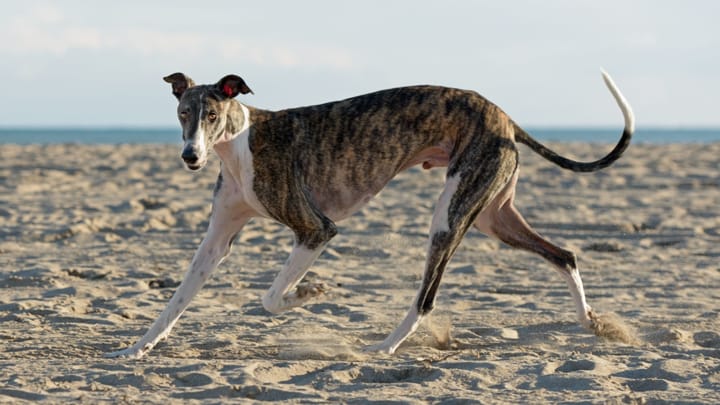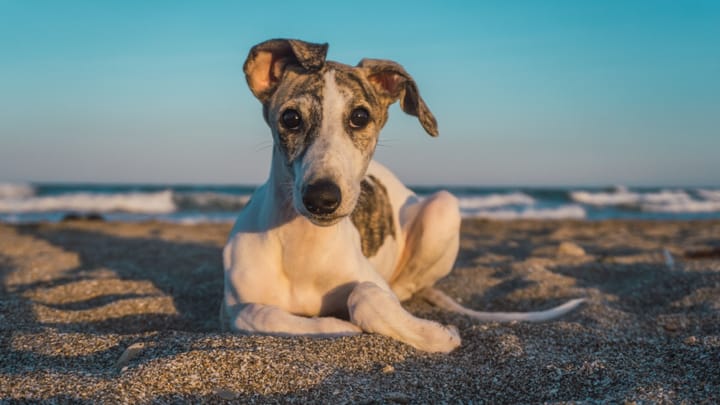Spanish Greyhound
Other name: Spanish Galgo


The Spanish Greyhound, more commonly known as the Galgo, is used exclusively as a hunting dog in its home country. As a result, unfortunately the Galgo is subjected to abuse if he’s not fast enough to hunt; they are often mistreated or even killed if they are not up to standard. Many European associations are trying to save these noble and sweet natured dogs. Galgos can be both energetic and reserved, as such they are suitable for many homes, even those with children, as they know how to be affectionate despite their reputation for seeming aloof.
|
Life expectancy |
The Spanish Greyhound has a life expectancy of between 10 and 14 years |
|
Temperament |
|
|
Size |
Large
|
|
Adult size |
Female
Between 24 and 27 in
Male
Between 24 and 28 in
|
|
Adult weight |
Female
Between 55 and 66 lb
Male
Between 55 and 66 lb
|
|
Coat colour
Spanish greyhounds can be any colour, but the most common are: tawny, brindle and black. |
Black Red |
|
Type of coat
Their coats are usually short. However, some may have a rough textured coat, for Spanish Greyhounds of this type, their fur is slightly longer. The Galgo’s fur is fine, short and smooth. As the name suggests, those with the rough coat have coarse and wiry fur with a beard, moustache and a tuft of hair on the head. |
Short |
|
Eye colour
Their eyes are usually dark hazel. |
Brown
|
Virtually unknown a few years ago, we are starting to see more of the Spanish greyhound at exhibitions. Despite this, they are still a rare breed and if you would like one you will either have to reserve a puppy well in advance or adopt one through a rescue association.
More details about the Spanish Greyhound
Spanish Greyhound: Origins and history
Their Spanish name is Galgo. It seems like this might be a contraction or evolution of the word “gallicus”. With this logic, their ancestor would have been a Gallic greyhound, arriving in Spain via France with the Celts in the sixth century BC.
However, the breed was already known in Roman times and there is no trace in France of their ancestor; this calls the theory of presumed French heritage into question.
It is more likely that the Galgo descends from Eastern Greyhounds which arrived in Spain from Africa, perhaps mixed with traditional Greyhound blood, as they closely resemble each other.
Physical characteristics of the Spanish Greyhound
The Spanish Greyhound is a good-sized, compactly built dog with a long, narrow head, a large chest cavity home to strong lungs, they have a well tucked up belly, and a long tail. Their head is proportional to the rest of the body, long and lean with diverging skull lines. Their eyes are almond-shaped; small and slanting. Their ears are high-set and broad at the base, relaxed when at rest, semi-pricked when the dog is alert. The long, low-set tail is solid at the base but folds into a hook at the tip, it falls between the legs and almost touches the ground: this is an essential and distinctive characteristic for a “typical” Galgo. Their limbs are straight and slim, parallel and perfectly in line with each other.
FCI classification of the Spanish Greyhound
-
Group 10 - Sighthounds
-
Section 3 : Short-haired Sighthounds
Spanish Greyhound: Characteristics
Spanish Greyhound: Behaviour
Training a Spanish Greyhound
These dogs are very rare in the UK, and even more so outside Spain. Because of this, when they are adopted it is often through a charity which fights against the poor treatment they suffer in Spain.
Thus, the training needed for a cute puppy who has not experienced any trauma is very different to the training required for a dog who has.
To educate, or rather to rehabilitate a Galgo, it is important to arm oneself with patience and gentleness. Consider their past; offer a stable and secure environment; meet their exercising needs and especially never use violence to be "respected".
Moreover, these dogs have, in addition to their often painful past, a strong and tenacious character that requires a firm hand and consistency.
Spanish Greyhound: Lifestyle
Breed compatibility Spanish Greyhound
Spanish Greyhound: Purchase price
The price of a Spanish Greyhound varies according to their lineage, age and sex. It is very difficult to find an exact price of a Galgo puppy.
On the other hand, they are a number of associations which rehome adult Spanish greyhounds after they have been mistreated or abandoned. The prices differ depending on the association, the dog’s past and their traumas as well as the expected veterinary costs in the short, medium or long term.
The average budget needed to meet the needs of a dog of this size is about £35 / month. In addition to this, it is necessary to budget for extra veterinary care for dogs that have suffered numerous abuses.
Spanish Greyhound: Shedding
Light
A plus to the Spanish greyhound is that like other greyhounds with a short coat they don’t lose too much hair. Additionally, as they don’t have an undercoat they don’t really moult.
Spanish Greyhound: Grooming
The Galgo doesn’t need any grooming and should not be given baths too often. Simple weekly brushing is helpful to maintain their beautiful glossy coats.
Spanish Greyhound: Health
Their life expectancy is around 12 years.
This is a strong and robust dog but they struggle in low temperatures.
Accustomed to a hot climate in their country of origin, this dog doesn’t struggle in the strong heat.
The Spanish greyhound has a strong aversion to the cold due to their lack of undercoat. A coat in winter is more than accessory but a necessity for them.
If they run every day the Galgo won’t put on any weight. They are far more often lean than they are fat.
No particular illness has been reported for this breed. Although it may look like they have a fragile physique they are in fact rather robust.





